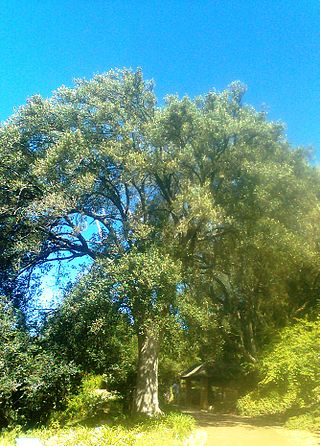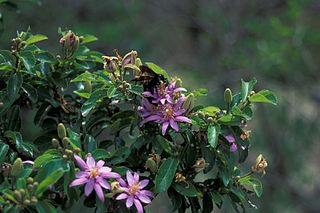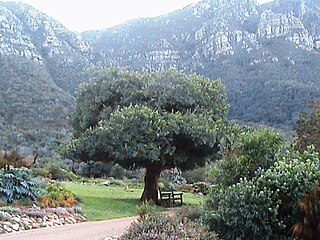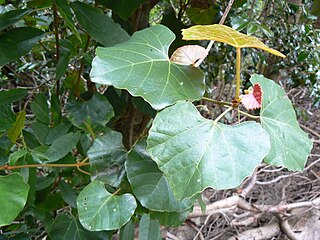
Curtisia dentata is a flowering tree from Southern Africa. It is the sole species in genus Curtisia, which was originally classed as a type of "dogwood" (Cornaceae), but is now placed in its own unique family Curtisiaceae.

Ocotea bullata, is a species of flowering tree native to South Africa. It produces very fine and valuable timber which was formerly much sought after to make furniture. Due to over-exploitation it is now a protected species. Other names for it are Cape Walnut, Cape laurel, and laurel wood. The name "stinkwood" comes from a strong smell that is released when it is fresh felled.

Diospyros mespiliformis, the jackalberry, is a large dioecious evergreen tree found mostly in the savannas of Africa. Jackals are fond of the fruit, hence the common names. It is a member of the family Ebenaceae, and is related to the true ebony and edible persimmon.

Aloidendron barberae, formerly Aloe bainesii and Aloe barberae, also known as the tree aloe, is a species of succulent plant in the genus Aloidendron. It is native to South Africa northwards to Mozambique. In its native climes this slow-growing tree can reach up to 60 feet (18 m) high and 36 inches (0.91 m) in stem diameter. An A. barberae planted at the Kirstenbosch Botanical Garden in Cape Town in 1922 had by 2011 grown to have a basal diameter of ten feet. Aloidendron barberae is Africa's largest aloe-like plant. The tree aloe is often used as an ornamental plant. Its tubular flowers are rose pink (green-tipped); it flowers in winter and in its natural environment is pollinated by sunbirds.

Podocarpus henkelii is a South African species of conifer in the family Podocarpaceae. It is grown ornamentally in gardens for its strikingly neat, attractive form and its elegant, drooping foliage.

Brabejum is a genus of a single species of large evergreen tree, Brabejum stellatifolium in the family Proteaceae, commonly called wild almond, bitter almond or ghoeboontjie. It is restricted in the wild to South Africa's Western Cape province, where it grows in thickets along the banks of streams. The plant is of botanical interest as being Africa's only member of the large grevilleoid subfamily. It is a bushy small tree with branches widely at ground level and numerous erect vigorous stems. Leaves grow up to 6 in (15 cm) long, narrow and bluntly toothed, appear at intervals along the branches, mostly in whorls of 6. In summer, the plant bears white flowers densely crowded on spikes arising from rusty buds at the leaf axils. The fruits to 2 in (5 cm) long, magenta to reddish brown, similar to an almond, appear in autumn. The nut is too bitter to eat; however, in earlier times it was boiled, roasted, and ground to make a "coffee" drink.

Celtis africana, the white stinkwood, is a deciduous tree in the family Cannabaceae. Its habit ranges from a tall tree in forest to a medium-sized tree in bushveld and open country, and a shrub on rocky soil. It occurs in Yemen and Somaliland and over large parts of Africa south of the Sahara. It is a common tree in the south and east of southern Africa, where the odour given off by freshly-cut green timber is similar to that of Ocotea bullata or black stinkwood.

Cunonia capensis, the butterspoon tree, butterknife tree, African red alder, red alder or rooiels, is a small tree found in the afromontane forests of southern Africa, and along rivers. It is grown as an ornamental in gardens for its attractive glossy foliage and its clusters of tiny, scented, white flowers. It is the only one of 24 species of Cunonia to occur outside of New Caledonia in the Pacific.

Kiggelaria africana is a large, robust, low-branching African tree, and is currently the only accepted species in the genus Kiggelaria.

Myrsine melanophloeos, commonly known as Cape beech, Kaapse boekenhout (Afrikaans), isiCalabi (Zulu) or isiQwane sehlati (Xhosa) is a dense evergreen tree that is native to the afromontane forests of Africa, ranging from Nigeria and Sudan to South Africa. Outside forests they are also commonly encountered along stream banks and in gullies.

Ilex mitis is a tall, dense, evergreen tree that is indigenous to Sub-Saharan Africa and Madagascar. It makes an excellent fast-growing hedge for gardens - growing tall, straight and dense.

Podalyria calyptrata is a small, resilient, fast-growing tree of the Fabaceae (legume) family. It has velvety silver leaves, bears masses of bright-pink, sweetly scented flowers, and is indigenous to the Western Cape, South Africa.

Apodytes dimidiata is a bushy tree with white flowers bearing a fragrance reminiscent of fresh coconut, and small black and red fruits. It is usually about 5 m tall, and it is indigenous to Southern Africa. The taxonomical family placement for this and other Apodytes was uncertain; it is now placed in the Metteniusaceae. Its English common name is in reference to the timber which is similar in appearance to that of the European pear tree of the northern hemisphere.

Cassine peragua, also known as Cape saffron, bastard saffron and forest spoonwood, is a medium-sized tree with fragrant flowers, decorative fruits and a saffron-coloured trunk. It is indigenous to the Afro-montane forests of South Africa.

Olinia ventosa, commonly known as the hard-pear. is a large, evergreen forest tree indigenous to South Africa.

Grewia occidentalis, the crossberry, is a species of deciduous tree, indigenous to Southern Africa.

Maytenus oleoides, commonly known as the mountain maytenus or rock false candlewood, is a dense, medium-sized tree that grows throughout the western half of South Africa. It is known as klipkershout in Afrikaans.

Canthium inerme (Turkey-berry) is a tough, adaptable medium-sized tree from South Africa. It bears small edible fruits and has a variety of uses in traditional medicine.

Rhoicissus tomentosa is a vigorous, evergreen vine that is indigenous to the afro-montane forests of southern Africa. It is increasingly popular as an ornamental creeper in gardens, and it has a wide range of uses in traditional medicine.

Protorhus longifolia, the red beech, is a medium to large, mostly dioecious species of tree in the family Anacardiaceae. It is native to South Africa and Eswatini, where it occurs in well-watered situations from coastal elevations to 1,250 m. The leafy, evergreen trees have rounded crowns and usually grow between 6 and 10 m tall, but regularly taller in forest.





























